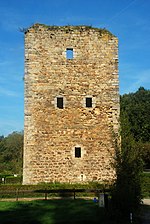The Battle of Gembloux (or Battle of the Gembloux Gap) was fought between French and German forces in May 1940 during the Second World War. On 10 May 1940, The Nazi Wehrmacht, invaded Luxembourg, The Netherlands and Belgium under the operational plan Fall Gelb (Case Yellow). Allied armies responded with the Dyle Plan (Breda variant), intended to halt the Germans in Belgium, believing it to be the main German thrust. The Allies committed their best and most mobile to an advance into Belgium on 10 May and on 12 May, the Germans began the second part of Fall Gelb, the Manstein Plan an advance through the Ardennes, to reach the English Channel and cut off the Allied forces in Belgium.
Unaware that the German invasion of the Low Countries was a decoy, the French Army intended to halt the German advance into central Belgium and France on two defensive positions at the towns of Hannut and Gembloux. The French First Army, the most powerful Allied army, was to defend the Gembloux–Wavre axis. The French Corps de Cavalerie (Général René Prioux), advanced to Hannut, to screen the deployment of the rest of the First Army at Gembloux, by delaying a German advance.
After the Battle of Hannut, some 35 km (22 mi) to the north-east, the French retired towards Gembloux and the principal defensive position for the French on the Belgian front. For two days French defeated attacks by elements of the 6th Army. The German surprise attack through the Ardennes and the crossing of the Meuse at Sedan, forced the First Army to retreat from Gembloux, then back over the French frontier towards Lille. The retreat disorganised the Allied defence on the central sector of the Belgian front and the German armies occupied central Belgium. Strategically the battle was inconclusive, it diverted the First Army from Sedan, which allowed the Germans to achieve the strategic goals of Fall Gelb but the First Army survived and during the Siege of Lille diverted German forces from the Battle of Dunkirk, which allowed the British Expeditionary Force and a substantial French contingent to escape.











